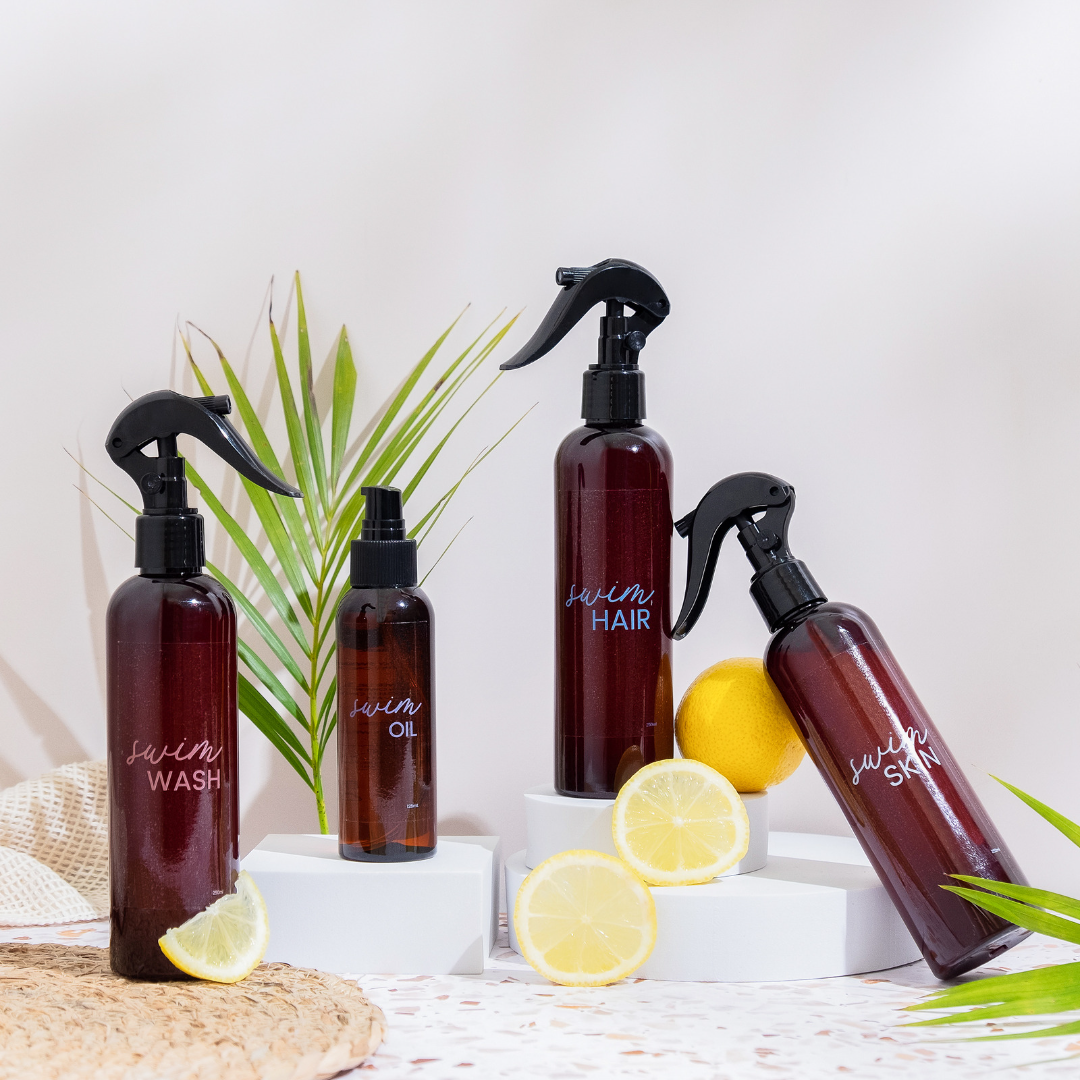Water Cannot Remove Chlorine
Did you know that rinsing after swimming does little to eliminate pool odor and/or skin irritation. Mitigating the effects of exposure to chlorinating and/or brominating agents requires reversing the chemical reaction between those chemicals and the proteins making up the human body.
I know most of you rinse the residual pool water your skin, hair + swim wear, after swimming, BUT such rinsing will not effectively eliminate all the adverse effects of exposure to the chemically-treated pool water. Traditional soaps are ineffective at breaking the millions of N-CL bonds that form on the skin and hair. For example, where the body's proteins have chemically reacted with the pool chemicals, they are physically changed but, at least in part, remain part of the body, i.e., they are not all rinsed away such as during normal showering.
Swimmers reek of pool chemicals even after showering and moving on to other activities because chlorine chemically bonds to hair and skin, so you need more than plain soap and water to wash it out.
Our products eliminate the chemical bonds + therefore instantly remove the chlorine on your skin, hair and swim wear.
Chlorine allows us to swim safely and comfortable, however the temperature pools are required to kept at, provide a suitable environment for living organisms, such as bacteria, to thrive.
As yuck as it sounds, as swimmers, we bring a variety of living and non-living substances with them into the pool. For example, things like our skin, hair, saliva, urine and sweat may come into contact with the pool water.
Chlorine itself as well as its by-products can have a dramatic impact on the outer layer of your skin. Some of the most common issues associated with chlorine exposure include:
Dry Skin – The acid formed when chlorine contacts water is a natural irritant to the skin. The more time spent in contact with it, the more irritating it can be. Add to that the fact that chlorinated water opens the pores, hypochlorous acid in essence strips the natural oils from the skin, causing dry, itchy, and irritated skin. This drying effect may even be a contributing factor to premature aging.
Irritated Skin – Considered irritant contact dermatitis, the rash commonly contracted with chlorine exposure is the chloramines present in the pool attaching to the skin after long periods of exposure. The risk is greater depending on the amount of chlorine as well as body waste present in the water; nonetheless, exposure may lead to a red, uncomfortable rash as well as inflammation that can progress to blister or hives.
Burns – Chlorine burns are also a potential hazard of exposure to a chlorinated pool or hot tub. This concern is more an issue of poor ventilation that causes gas build up; however, if your skin does come into contact with the by-products or off-gas of pool chlorine, you can sustain burns, blisters, and hives.
Exacerbated Conditions – If you already have hypersensitive skin from a pre-existing condition such as psoriasis, eczema, or dermatitis, chlorine exposure will likely make it worse. The hypochlorous acid present in chlorinated water causes further inflammation of the skin, which can lead to an increase of pain, dryness, redness, itchiness or scaling already present in the skin.
Loss of shine and flexibility in hair - Chlorine strips the natural oils that cover your hair. This results in weak and brittle strands that can be more prone to breakage and damage. Letting your hair soak too long in pool water can cause the hair shafts to absorb the chlorine, resulting in severe drying of the cuticles, which in turn can result in limp and lifeless hair.
Split ends and damaged strands - Chlorine can actually get between the hair fibres, and once the chemical starts to crystallise within the hair shaft, the crystals can separate these fibres, thus destroying the structural integrity of strands of hair, causing split ends and roughness.
Premature aging - Chlorine can seep into your skin through open pores. Over a period of time, this can damage your skin and cause premature signs of aging. Chlorine also tends to strip the skin of the natural oils that keep skin supple and protected against the elements, causing it to dry up and crack, which may lead to wrinkles and lines.
Dry and flaky skin - While an occasional dip in the pool may not affect your skin noticeably, spending long hours each day swimming and soaking in chlorinated water will, of course, exacerbate its effects on the skin. If you have sensitive skin, you may develop a rash or suffer from dry and flaky skin.
Chlorine can kill good bacteria - While chlorine is good at getting rid of the harmful bacteria that makes us sick, it is also capable of killing off good bacteria and beneficial microflora on which our healthy skin relies. Certain studies have shown that chlorinated water also destroys vitamin E and polyunsaturated fatty acids.
Chlorine can weaken + fade swim wear - Frequent swimmers know that chlorine can damage not only your skin and hair, but also your swimsuit. In time, the fabric will shred, the color will fade, and the elastic will break down. It can also turn your white suit yellow.
The Technical Explanation
Chlorine may be a long-standing disinfection success story, but the reality is that the very process that delivers such good results has an irritating downside: by-products that are harmful to the skin (and the rest of your body).
When chlorine contacts water, a reaction occurs that forms hypochlorous acid. During this process of chlorination, the hypochlorous acid breaks down the cellular components of pathogens to eliminate them.
That process is what is supposed to happen when a pool is treated with chlorine. However, it doesn’t stop there. Once it’s broken down these compounds, the hypochlorous acid combines with them forming what are known as chloramines.
Chloramines not only smell awful, but they also reduce the potency of the free chlorine remaining in the pool, which in turn, hinders chlorines ability to further disinfect the water. This reaction makes it easier for pathogens to survive in the pool and contaminate any swimmers.
In addition to potentially causing illness, chloramines are also among the components that cause harm and irritation to the skin. But they aren’t the only issue. Pools are usually treated with chemicals chosen to prevent the growth of harmful organisms, such as bacteria and parasites like E. coli. Properly used, these chemicals keep the pool water substantially free from harmful contaminants. The chemicals used to treat pool water work by reacting with certain molecules that come into contact with the pool water.
Although a swimmer can rinse the residual pool water from their skin, hair, swimwear, etc., after swimming, such rinsing will not effectively eliminate all the adverse effects of exposure to the chemically-treated pool water. Traditional soaps are ineffective at breaking the millions of chemical bonds that form on the skin and hair.
If you don’t shower after swimming, notice the chlorine smell become more prominent when your skin and hair are exposed to moisture, like sweat or when you jump in the shower, your skin and hair will release the remaining pool chemicals. That’s why when you jump into a shower, even after swimming a few days ago, you instantly smell chlorine, this is the chlorine that was absorbed by your skin and was unable to be removed with just rinsing under water.
What is Chlorination + Bromination?
Bromination is a chemical process in which a compound reacts with bromine, resulting in the addition of bromine to the component. The technique of adding chlorine to drinking water to kill parasites, germs, and viruses is known as chlorination.
After swimming in a pool with a chlorinating and/or brominating agent, proteins of the human body may become chlorinated and/or brominated. Subsequent exposure of those chlorinated and/or brominated amino groups to water (e.g. rain or sweat) may release these volatile chemicals, which may be corrosive or irritating.
Green hair, shiny hair and loss of body hair are secondary problems associated with the N-CL reaction with human skin and hair.
Why would we do it with all these negatives to swimming in chlorinated water? Um because it’s awesome + fun + a great way to stay fit + did I say fun?
Now you can enjoy the fun without the worrying about of ANY of the above negatives, instantly remove the chemical elements from your skin, hair + swim wear.


